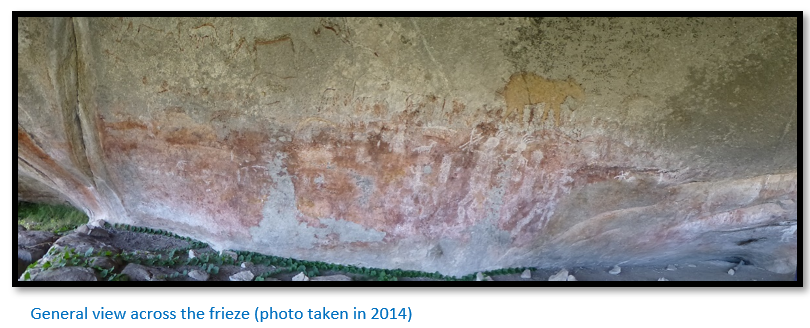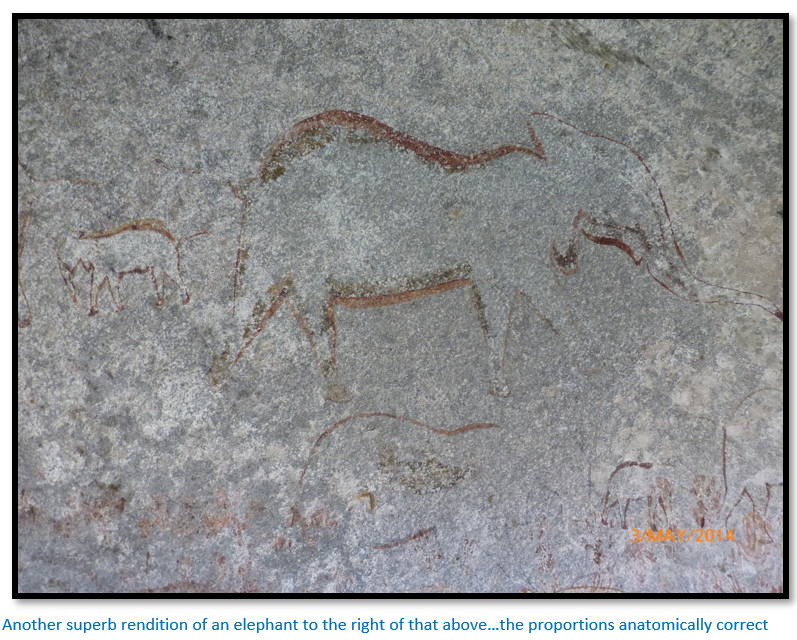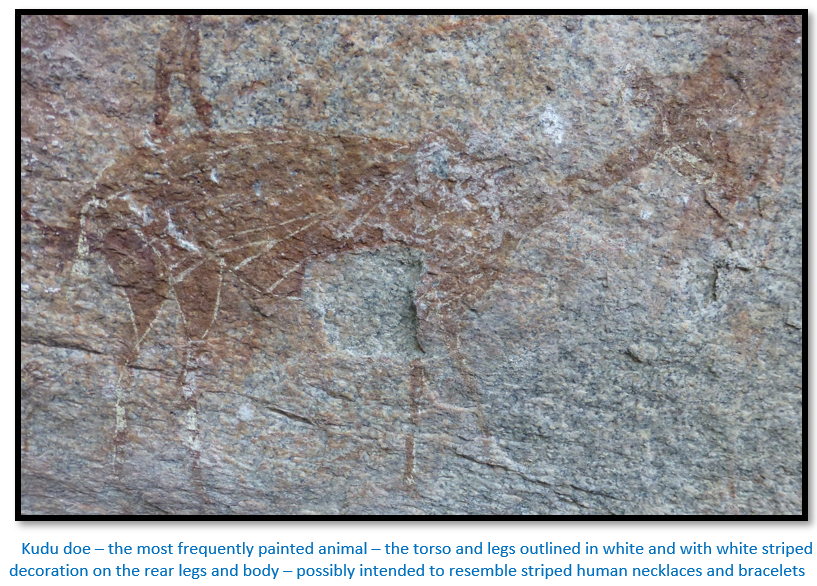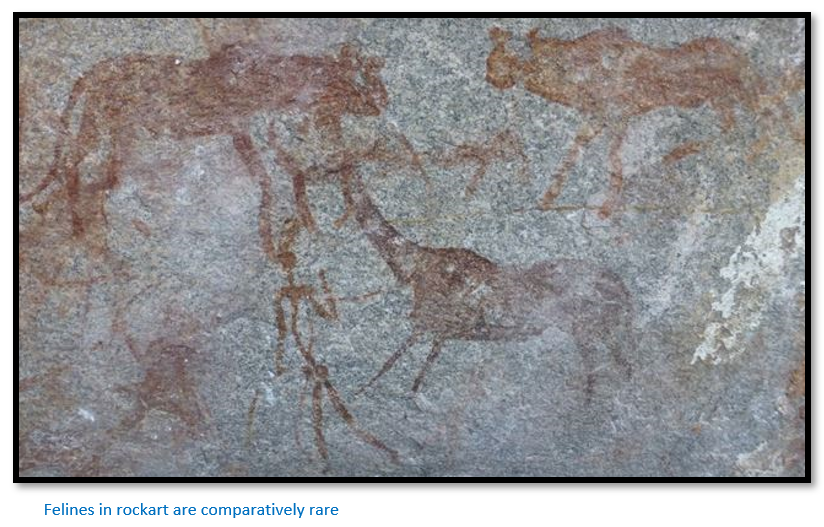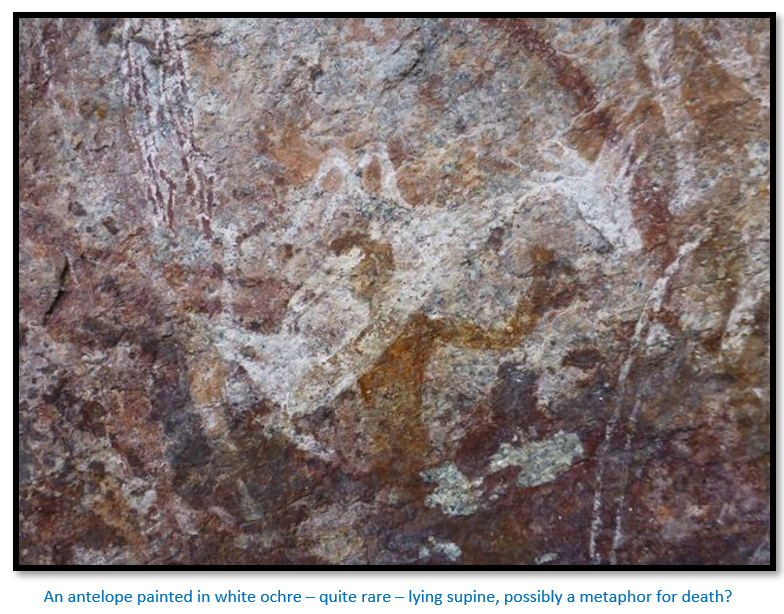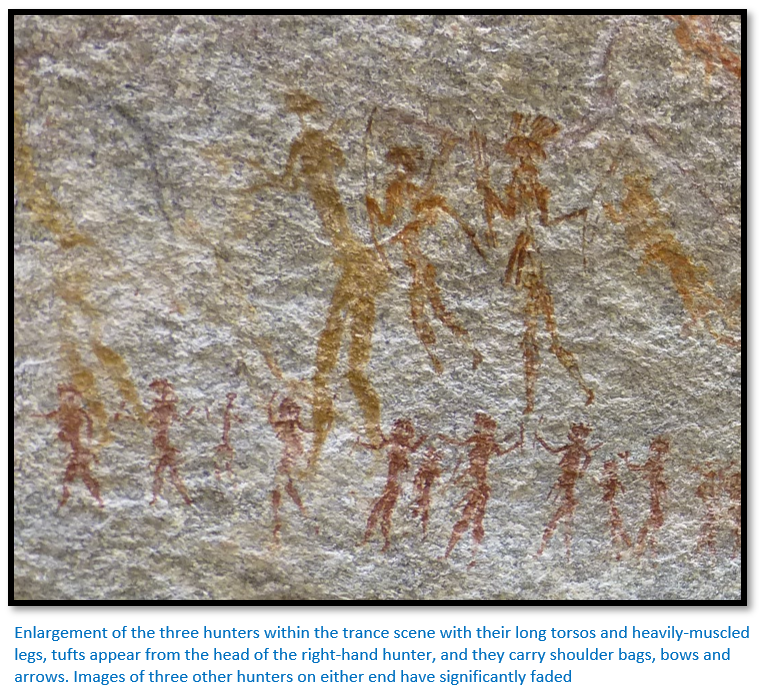Chikupo Rock Art Shelter – the Northern Cave
Peter Garlake states the Chikupo caves contain probably the greatest number of paintings remaining on any site in Zimbabwe, many in excellent condition.
Fairly easy to access from Harare, perhaps 90 minutes journey on good to fair road. 4WD not required, although high clearance is advised for driving in the Communal lands.
The descriptions of the sites follows Peter Garlake in his outstanding book: The Painted Caves; an Introduction to the Prehistoric Art of Zimbabwe, the best of the available guides and the only one before or since that is original in its thoughts and ideas.
Jørn Støvring in his book called New Approach to Cave Art in Zimbabwe; Glimpse into the Mentality History of the Ancient San in the period from 10 000 BC to 600 AD is to be congratulated for his attempt to create a new understanding of the rock art concentrating on Mashonaland and is to be commended for assisting in creating a database of over 3,000 high quality photographs.
It appears that the collaboration with National Museums and Monuments of Zimbabwe (NMMZ) was a productive one. Rockart research on this subject in Zimbabwe does not appear to have received much attention – no doubt due to the low priority given to this period, Zimbabwe’s continuing economic malaise and lack of funding and the political priorities of the various Directors of the NMMZ. Hopefully, all these shortcomings will be addressed in the future through further collaborations such as this one.
Leave Harare on the Borrowdale Road, distances are from Borrowdale police station. 13.4 KM the road crosses a grid and enters the Chinamora Communal Lands. 16.3KM pass the signpost to Domboshava National Monument. 26.6 KM pass the signpost to Ngomakurira National monument. 30.0 KM leave the tar road and turn left onto the dirt road. 34.8 KM pass Chinamora School primary / secondary school, 39.4 KM pass Jingo School, 43.1 KM turn right at T-junction. 51.0 KM turn right at Chisiga store for Masembura School: 52.3 KM pass Masembura School turnoff. Do not take the right fork. Pass the large granite dome on your right. Chikupo is the large low hill ahead on the right; 56.5 KM turn right onto the track and park at the foot of the hill. I suggest you ask a local person to guide you the last few hundred metres. The Borrowdale road to the Chinamora Communal Lands is a good tar road. The next 17 KM of tar road is much repaired with numerous potholes. The dirt road to site is quite passable in 2WD as long as caution is taken where the road gets eroded in the rains. Journey takes about one and a half hours.
The Chikupo caves are facing you on the east side of the hill and are reached by taking the path and then turning right up a short, scree slope. There are three caves within close proximity. The Southern and Central caves are easily reached, but the Northern cave has a slippery exterior rock face and is most easily climbed at the western end. The Western cave is out of sight of the three caves and is best reached by scrambling over the neck of the bare granite hill. Once passed, the cave is visible above you. Alternatively walk west around the base of the hill and climb. The paintings are in the higher of the two caves. If you run out of time, I suggest you omit the Western cave.
The three adjoining caves at Chikupo Mountain:
Southern and Central cave GPS reference: 17⁰26′42.55″S 31⁰17′21.18″E
Northern cave GPS reference: 17⁰26′40.48″S 31⁰17′25.78″E
and another across the valley:
Western Cave GPS reference: 17⁰26′41.83″S 31⁰17′17.30″E
The Northern Cave at Chikupo has a short steep and slippery slope on the western end to negotiate, but once accomplished there are wonderful views over the adjoining kopjes and communal lands to the north and west.
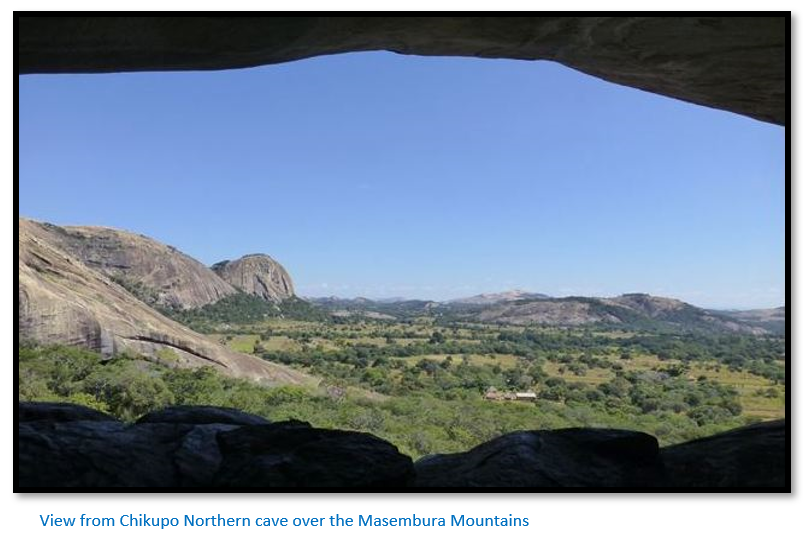
Starting from the northern end are many well-drawn outlines of elephants, including babies, in four rows; the lower ones largely obscured by later paintings. One, top right and shown in the photo below, has an ochre infill; the remainder are in outline with their bellies and backs highlighted in red ochre. They show great observation and realism and probably will be the highlight of this rock art site for many visitors.
In a scene unique in Zimbabwe’s rock art, a line of handprints are at the feet of the elephants. They probably once extended right across the cave as examples can be discerned all along the wall. Garlake estimates there were probably over 150 originally, of which at least 50 remain. Paint was applied to the palm and fingers and the hand pressed against the rock, some are visible on the photo above. Interestingly the yellow ochre on the elephant above was clearly added later than the outline, as it overlies the handprints.
Under the elephants are many files of hunters, some outlined and decorated in white. They have been defaced by several crude, post-Stone Age imitations of hunters over one metre high which have been finger painted in a white clay-like substance that does seem to be relatively permanent.
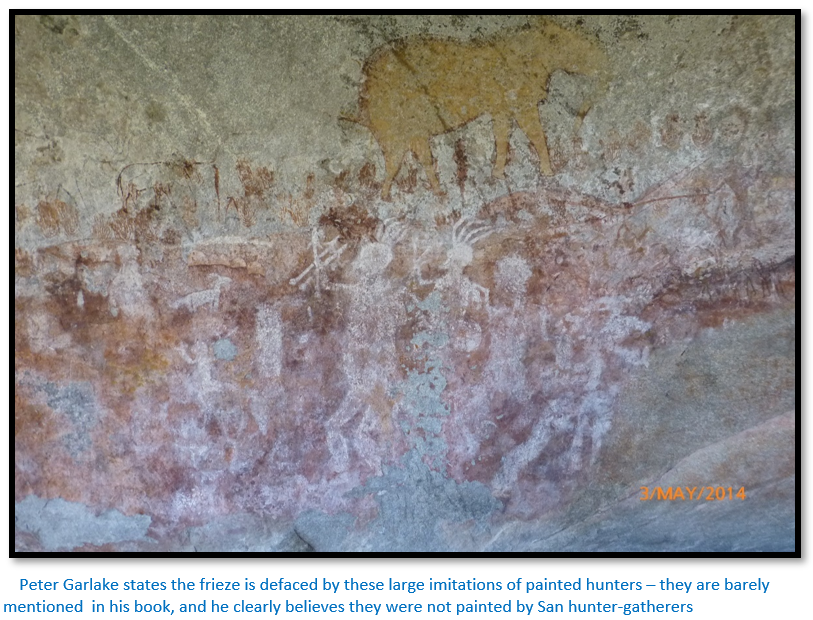
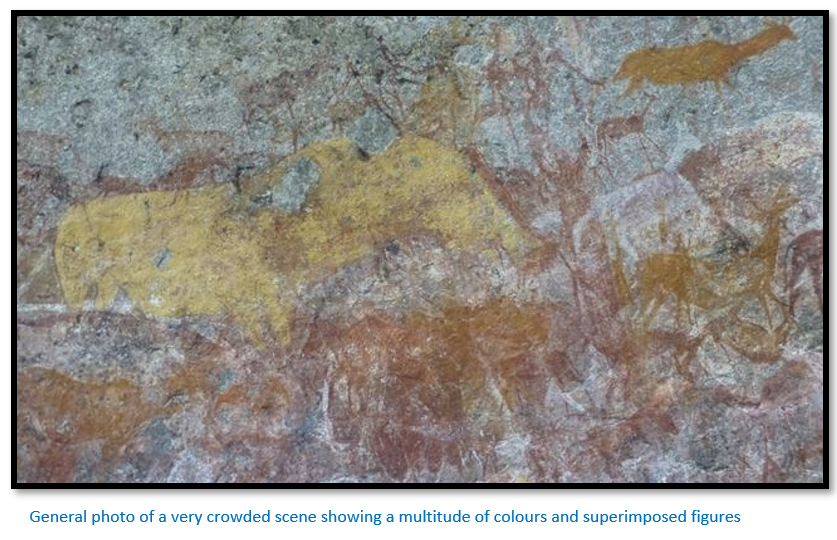
Garlake describes the large area of yellow ochre as representing an unidentifiable animal, but I believe the left-hand side to be an elephant facing outward with the object on the right-hand side representing a supine antelope, its legs at the top folded inwards and pointing left along the body.
Many paintings are seen as superimposed, that is they have been painted over and superimposed on other paintings, often obliterating and destroying the beauty of earlier images. This practice bewildered many earlier researchers, as it is almost unknown to destroy earlier works. However, the San may have seen each painting as a living, continuing and potent force. If a frieze was seen as never finished, or completed, then it would be legitimate for later artists to add to earlier paintings, to superimpose and juxtapose new work with earlier work.
Numerical analysis in South Africa indicate that superimpositioning and juxta positioning in painting followed definite rules. The process of adding to and altering paintings would add to their power, or potency and results in dense masses of images that spread from the centre of the frieze to the periphery.
In addition to the mass of painted antelope images are well-painted baboon, some kudu outlined in white paint and two felines, probably cheetahs.
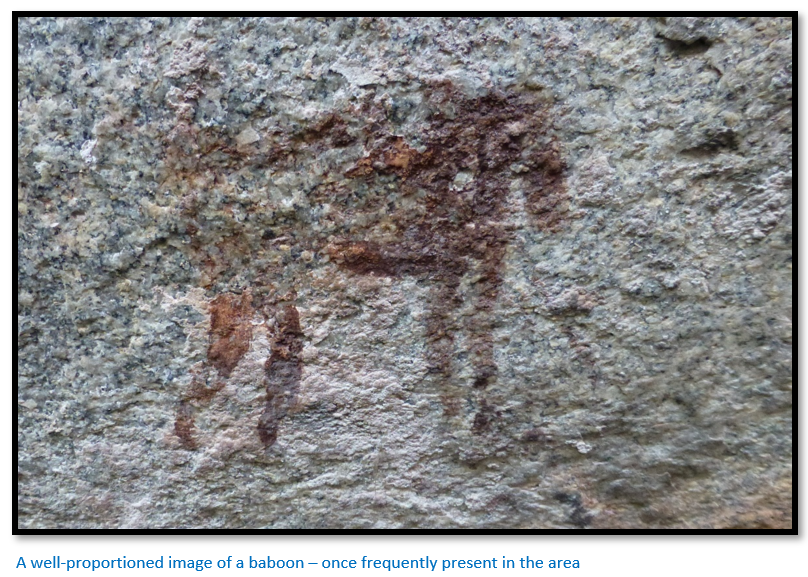
In the centre of the cave around the large area of yellow clay described above, are the remains of many kudu and other images. On its right is the clearest and largest of several ovals, or what Leo Frobenius called formlings, composed of eight white elements with white semi-circular tops and bottoms and the usual red rectangle in the centre. A figure just below them has lines coming from his arms and hand. Below him, a kudu has been over painted with a pattern of white lines, another lies supine.
To the right of the supine antelope, not easily seen, is a white snake with an animal head. Below and right of its head are three hunters with hair on end and a figure also with lines coming from the head, one ending in an animal head.
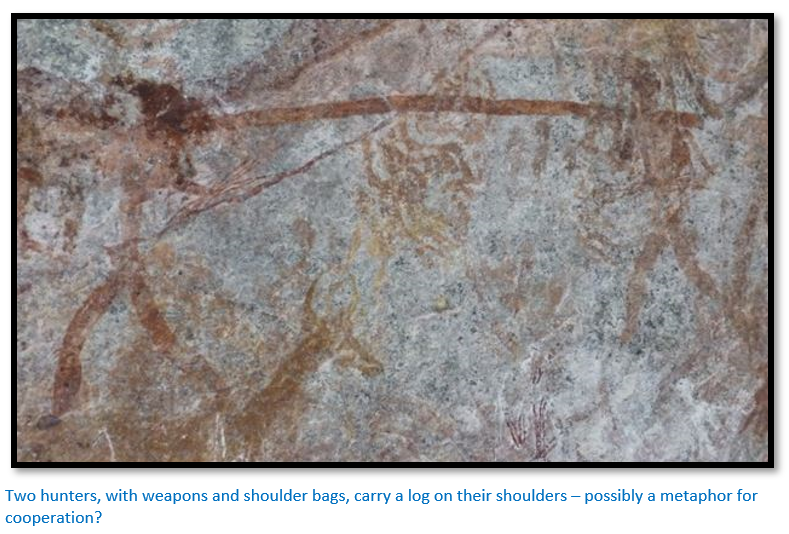
Moving west on the cave roof, is a trance scene. Seventeen crouched dancers including children, some wearing capes and a feather in their heads, some with tail feathers or lines from their rumps, are surrounded by participants and typical camp equipment of shoulder bags and weapons. Superimposed in the centre, in a different style and paint colour, a trancer lies prone. Five larger hunters with weapons, some in headdresses, have been superimposed on the trance scene in a distinctive yellow ochre.

Some San dances are simply for pleasure and socialising. However, the most significant dances are concerned with curing, not so much of sick individuals, although this does happen, as of removing potential evil or sickness from every member of the group. All dances take place in the centre of the group. The men lean forward with knees bent and move with small, controlled hops and skips in a circle. Their only musical instruments are rattles made of seed pods tied around their ankles. The women squat, singing and clapping rhythmically, or may join in the circle of dancing men and participate fully in the dance.
In a medicine dance, some of the participants, although not more than two or three at a time, pass into trance, a state called !kia, achieved mainly through hyperventilation. The trance state induces shivering, trembling, sweating, rigidity and sometimes nose bleeding. It produces visions and hallucinations for the trancer, and they enter the spirit world. In trance, they can cure patients, by removing evil influences from the patient to the curer. This is done by fluttering the trancers hands against the patient’s chest and back and finally throwing the evil out and back to the gods with a violent gesture of both arms. The spirits of those in deep trance are believed to leave the body and travel outside it. Read the article on Thetford Game Reserve Rock Art under Mashonaland Central on the website www.zimfieldguide.com for a more detailed explanation of trancing with illustrations.
References
Peter Garlake. The Painted Caves, an introduction to the Prehistoric Rock Art of Zimbabwe. Modus Publications. 1987
Peter Garlake. The Hunter’s Vision, the Prehistoric Art of Zimbabwe. Zimbabwe Publishing House. 1995
Thomas N. Huffman. The Trance Hypothesis and the Rock Art of Zimbabwe. South African Archaeological Society. Goodwin Ser. 4. 1983
Rupert Isaacson. The Healing Land. Geographical 73.7; 7 (2001): 53
Richard Katz. Boiling energy: community healing among the Kalahari Kung. Cambridge, Mass. Harvard University Press. 1982
J. David Lewis Williams. Believing and Seeing. Academic Press. 1981
Lorna Marshall. The Medicine Dance of the !Kung Bushmen. Journal of the International African Institute 39: 347-381. 1969
Martin D. Prendergast. Early Iron Age furnaces at Surtic Farm, near Mazowe, Zimbabwe. SAAB Bulletin 38: 31-32. 1983
Jørn Støvring. New Approach to Cave Art in Zimbabwe; Glimpse into the Mentality History of the Ancient San in the period from 10 000 BC to 600 AD. 2021


